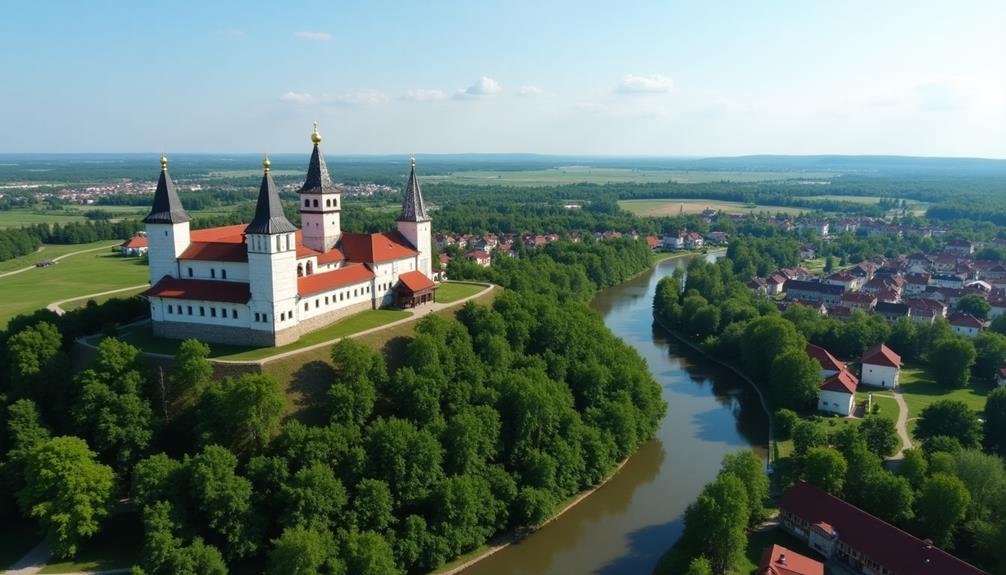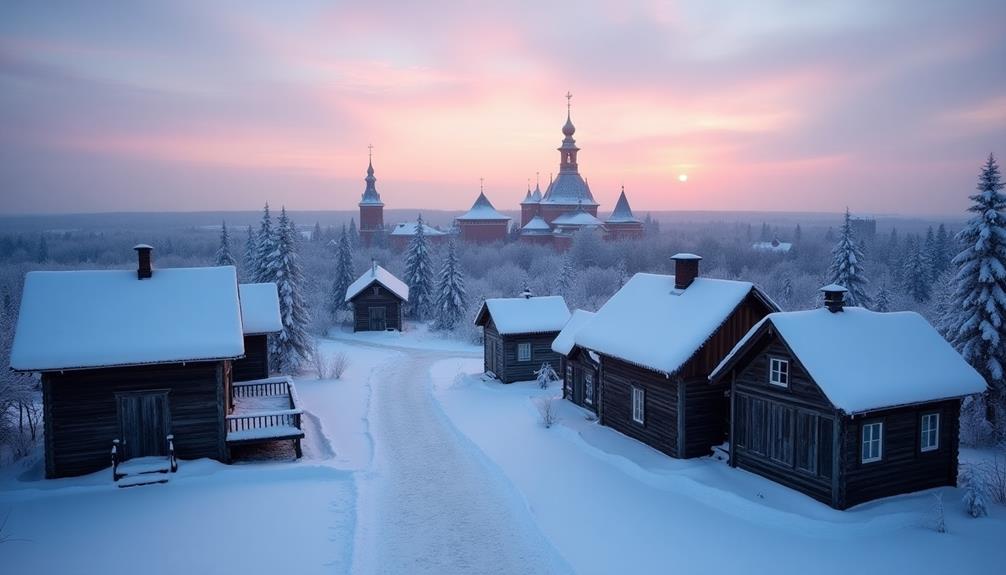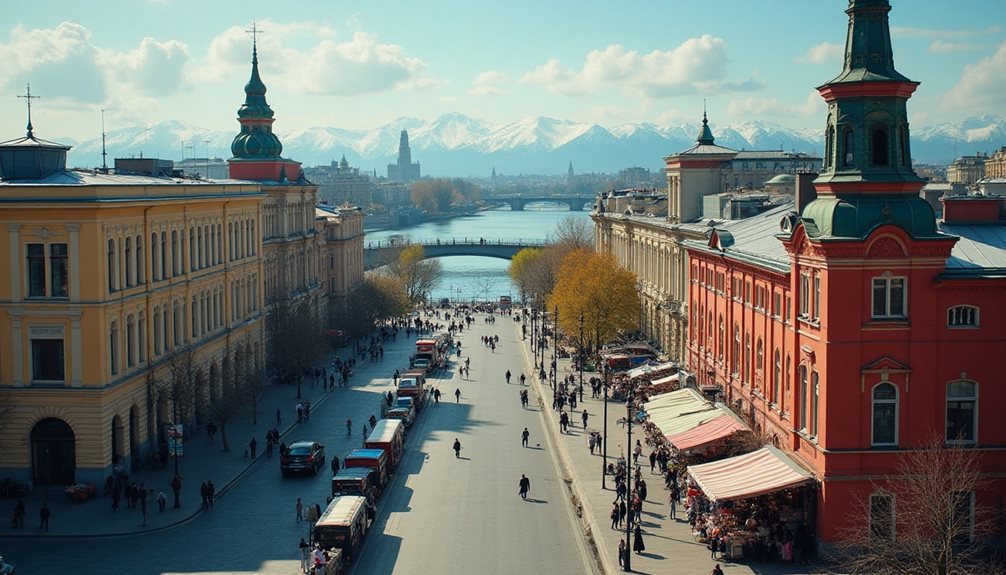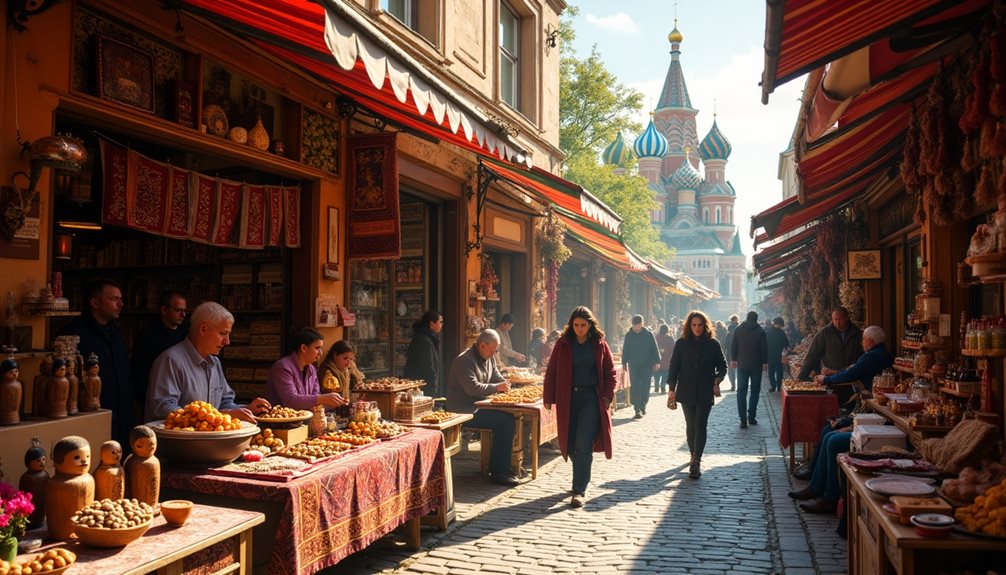Introduction

Nestled in the heart of Russia’s vast Siberian landscape, the city of Tobolsk stands as a symbol to a storied past that dates back several centuries. Founded in 1587, it rose to prominence as the capital of Siberia, a hub of trade and cultural exchange.
Today, Tobolsk tourism thrives on its rich history, offering visitors a glimpse into its vibrant past through historical festivals and art exhibitions. The city’s unique local cuisine delights the senses, while educational initiatives highlight its role in shaping Siberian heritage.
Analyzing Tobolsk’s historical significance, one sees a city that not only preserved its cultural identity but also embraced new opportunities for growth, inviting those who seek freedom and exploration to uncover its enduring legacy.
ТОБОЛЬСКИЙ КРЕМЛЬ (Tobolsk Kremlin)
Although Tobolsk’s historical significance is multifaceted, the Tobolsk Kremlin stands as a tribute to the city’s strategic and cultural importance in Russian history. Established as a pivotal center in the late 16th century, Tobolsk became a hub for economic development, facilitating trade routes that enriched the region.
The city’s history is peppered with cultural festivals that celebrate its diverse heritage, drawing from indigenous Siberian and Russian influences. These events, alongside the unique local cuisine, offer a taste of tradition and innovation.
As the only stone kremlin in Siberia, it reflects the region’s historical preservation efforts and draws visitors for Tobolsk tourism.
Over the centuries, the fortress has witnessed Siberia’s evolving identity, serving as a backdrop for local festivals that celebrate its rich culture.
The layout and design of the Kremlin offer a chronological insight into the architectural styles that shaped its construction, making it a focal point for architectural tours.
Visitors often pair their exploration with Siberian cuisine, immersing themselves in the local flavor while marveling at the Kremlin’s grandeur.
Construction of the Kremlin
Semyon Remezov, a prominent figure in Siberian history, played a pivotal role in the construction of the Tobolsk Kremlin.
In the late 17th century, Remezov’s mastery in historical cartography guided him in designing key structures that would embody Tobolsk architecture and Siberian influence. His visionary approach to cultural preservation was instrumental in ensuring the Kremlin’s enduring legacy.
Situated within the historical tapestry of the Tobolsk Kremlin, the four towers—Pavlinskaya, Yuzhnaya, Orlovskaya, and Granovitaya—embody a fascinating evolution of architectural styles spanning from the 17th to the 20th centuries.
Each tower reflects its era’s unique artistic and structural innovations, offering a profound insight into the architectural evolution of Siberia. The Pavlinskaya Tower stands as a representation of early Russian fortification designs, while the Yuzhnaya and Orlovskaya towers illustrate the blend of defensive and decorative elements.
The Granovitaya Tower, with its intricate 20th-century details, symbolizes cultural resilience. These towers not only serve as essential components of historical preservation but also as compelling tourist attractions, drawing visitors keen to explore their cultural symbolism and storied pasts.
Among the notable structures within the Tobolsk Kremlin, the St. Sophia-Assumption Cathedral stands as a beacon of cathedral architecture. Constructed in the late 17th century, this edifice became a prototype for Moscow’s Ascension Church, showcasing architectural brilliance and religious significance.
Over the centuries, the cathedral has been a focal point of pilgrimage traditions for Orthodox Christians, offering spiritual solace and reinforcing cultural symbolism. Its presence within the Tobolsk Kremlin marks significant historical events, echoing the era’s religious fervor.
Standing as a symbol to Russia’s historical narrative, the Tobolsk Kremlin’s significance extends beyond architectural marvels and restoration efforts.
In the early 19th century, it bore witness to the Decembrist Exiles, individuals who challenged autocratic rule and sought political reform. Their presence in Tobolsk marked a pivotal chapter in Siberian heritage, as the city became a refuge for political prisoners.
Fast forward to the 20th century, the Kremlin’s walls also sheltered the family of Nicholas II, Russia’s last Tsar, during their captivity.
These historical events underscore Tobolsk’s role as a backdrop for transformative moments in Russian history. The Kremlin stands as a silent witness to the struggle for freedom and enduring legacy of those who sought change.
РЕЗНАЯ КОСТЬ (Carved Bone)

In the heart of Tobolsk, the cherished tradition of bone carving (РЕЗНАЯ КОСТЬ) has been meticulously preserved and passed down through generations, serving as a tribute to the city’s rich cultural heritage.
This artisan tradition thrives on traditional techniques honed by local artisans, fostering a unique craftsmanship legacy that captivates both residents and visitors.
Community workshops serve as essential hubs where these skills are shared and refined, ensuring the continuity of this intricate art form.
The artisan tradition of bone carving (РЕЗНЯЯ КОСТЬ) in Tobolsk, with its roots embedded deeply in the 17th century, marks an era where intricate craftsmanship became a mirror reflecting the city’s vibrant local life, enduring traditions, and rich mythology.
Innovation in craftsmanship is exemplified by the only Russian Bone Carving Factory in Tobolsk, which continues to produce unique souvenirs using materials such as mammoth tusk.
Established in the heart of Siberia, this factory stands as a symbol of the enduring legacy of bone carving, blending ancient artistic techniques with modern craftsmanship.
The use of mammoth tusk, a material deeply tied to the region’s history, enhances the cultural significance of each piece.
Craftsmen employ meticulous techniques that have evolved over centuries, ensuring each souvenir is a distinct artifact.
As one explores the intricate craft of bone carving in Tobolsk, it becomes evident that this art form serves as an essential conduit for preserving Siberian culture and identity.
Rooted in centuries-old traditions, it embodies the essence of cultural storytelling, intricately weaving tales of the past into each carved piece. This traditional craftsmanship is not merely decorative; it is a profound expression of artistic heritage.
Each carving is a reflection of identity preservation, capturing the spirit and resilience of Siberian folklore representation. Through the skilled hands of artisans, these stories transcend time, offering an enduring connection to ancestral roots.
As Siberians carve their narratives into bone, they guarantee that their vibrant history remains alive, thriving amidst the vast Siberian landscape.
Folklore Sculptures and “The Little Humpbacked Horse”
The renowned factory in Tobolsk has become a vital hub for crafting sculptures that draw inspiration from local folklore, particularly the beloved characters from Pyotr Yershov’s fairy tale, “The Little Humpbacked Horse.
This tale, cherished in Russian literature, offers a rich tapestry of myth and imagination that artisans skillfully transform into tangible art forms through the medium of carved bone.
Building on the tradition of crafting sculptures inspired by “The Little Humpbacked Horse,” the town of Tobolsk has seen a remarkable evolution in its artistic endeavors, especially in the domain of carved bone.
This ancient art form has been invigorated by urban development and infrastructure improvements, attracting artists and entrepreneurs alike. As craft workshops open their doors to enthusiastic tourists, the tangible tourism impact becomes evident. This influx of visitors supports the local economy and fuels the preservation of Tobolsk’s rich heritage.
ДМИТРИЙ МЕНДЕЛЕЕВ (Dmitri Mendeleev)
Born in Tobolsk in 1834, Dmitri Mendeleev’s early education in this culturally vibrant city played a vital role in shaping his intellectual pursuits, eventually leading him to formulate the periodic table of elements, a cornerstone of modern chemistry.
Dmitri Mendeleev, one of the most influential chemists of the 19th century, was the youngest of 17 siblings in a family that faced significant challenges. Born in Tobolsk, a city influenced by the harsh Siberian climate, Mendeleev’s early life was marked by the economic struggles of his family, particularly after his father’s blindness.
The Tobolsk economy was limited, yet it fostered a resilient community spirit enriched by cultural festivals and local cuisine. Despite adversities, the city’s educational institutions provided Mendeleev with the foundation to pursue academia.
These institutions, though modest, were a beacon for intellectual curiosity, nurturing a desire for freedom and exploration in young minds. This backdrop laid the groundwork for Mendeleev’s future groundbreaking contributions to chemistry.
Mendeleev and the Periodic Table of Elements
Mendeleev’s discoveries, most significantly the formulation of the periodic table, redefined the boundaries of chemical science. His work provided a systematic framework that allowed for the prediction of undiscovered elements, illustrating the power of scientific vision.
As Mendeleev’s periodic table gained prominence, it became a cornerstone of chemistry education, influencing generations of scientists.
Dmitri Mendeleev’s profound influence on Tobolsk extends beyond cultural significance to tangible commemorations throughout the city. Designated an honorary citizen, Mendeleev’s legacy is immortalized through various landmarks, including a university and street named in his honor.
His contributions to scientific education are celebrated through these institutions, fostering local innovations and encouraging community involvement in scientific pursuits. Chronologically, the establishment of these sites marked a pivotal point in integrating Mendeleev’s Influence into the city’s identity.
Every year, Tobolsk commemorates the legacy of Dmitri Mendeleev through a series of meticulously organized events and educational programs.
These annual celebrations kick off with community engagement activities, fostering a spirit of scientific inspiration among residents.
Chronologically, the festivities progress with educational initiatives that highlight Mendeleev’s groundbreaking achievements, offering forums and workshops dedicated to both students and educators.
Youth programs take center stage, aiming to ignite curiosity and passion for science in young minds. Participants are encouraged to explore Mendeleev’s contributions, nurturing future scientists through hands-on experiments and interactive lectures.
As Tobolsk continues to honor Dmitri Mendeleev’s contributions to science, it becomes evident that his influence extends far beyond the domain of chemistry, deeply permeating the cultural fabric of the city.
The annual Tobolsk festivals celebrate this legacy, blending scientific commemoration with vibrant displays of local cuisine and traditional music, offering a feast for the senses.
Over time, art exhibitions have emerged, inspired by Mendeleev’s innovative spirit, showcasing the creativity of local artists.
These events foster a sense of community, encouraging residents to engage in projects that highlight the city’s rich heritage.
Chronologically, the integration of Mendeleev’s legacy into these cultural elements reflects a dynamic evolution, where Tobolsk’s identity thrives on historical reverence and progressive cultural expression.
Museums Dedicated to Mendeleev’s Work
Numerous exhibitions and museums in Tobolsk stand as a tribute to Dmitri Mendeleev’s enduring legacy, underscoring his pivotal role in the advancement of science.
These scientific exhibitions not only highlight Mendeleev’s influence on chemistry but also integrate local education by inspiring young minds. From his formulation of the Periodic Table to his historical contributions in various scientific fields, Mendeleev’s work continues to resonate.
Chronologically, these exhibitions trace his journey, offering contextual insights into his groundbreaking discoveries. In addition, cultural celebrations within Tobolsk often feature Mendeleev’s achievements, intertwining scientific pride with local heritage.
Through these endeavors, Tobolsk positions itself as a beacon of intellectual curiosity, inviting freedom-loving individuals to explore the profound impacts of one of Russia’s eminent scientific figures.
While Tobolsk’s exhibitions and museums honor Dmitri Mendeleev’s scientific achievements, his legacy also permeates the cultural fabric of the city, elevating local pride as the birthplace of influential thinkers.
Chronologically, Tobolsk education has been pivotal, nurturing minds that contribute greatly to various fields. Celebrating these achievements, cultural festivals in Tobolsk highlight the city’s historical figures and their scientific contributions, fostering a sense of shared heritage.
Analyzing this dynamic, it becomes evident that Mendeleev’s impact extends beyond academia into everyday local life, including local cuisine, which draws inspiration from his innovative spirit.
Contextually, this blending of science and culture exemplifies Tobolsk’s unique identity, offering a fertile ground for aspiring minds seeking freedom through knowledge and creativity.

As one explores the cultural tapestry of Tobolsk, it becomes apparent that its rich heritage is anchored by significant landmarks and traditions that have shaped its historical narrative.
The Kremlin stands as a symbol of Tobolsk’s architectural grandeur, drawing visitors to its cultural festivals and engaging them with local cuisine.
Bone carving, a cherished craft, echoes the city’s artistic lineage, celebrated through traditional music and contemporary art exhibitions.
The legacy of Dmitri Mendeleev, a native son, enriches the intellectual fabric of Tobolsk, inspiring tourism initiatives that honor his scientific contributions.
Cultural festivals invigorate this heritage, celebrating artistic expressions and fostering a community identity that bridges past and present.
Local cuisine, an amalgamation of diverse influences, offers a culinary journey that echoes the city’s rich history.
Through these elements, Tobolsk not only preserves its storied past but also invites contemporary audiences to experience a tapestry of culture and freedom.
Accordingly, Tobolsk stands as a reflection of Russia’s vibrant historical and cultural landscape.





